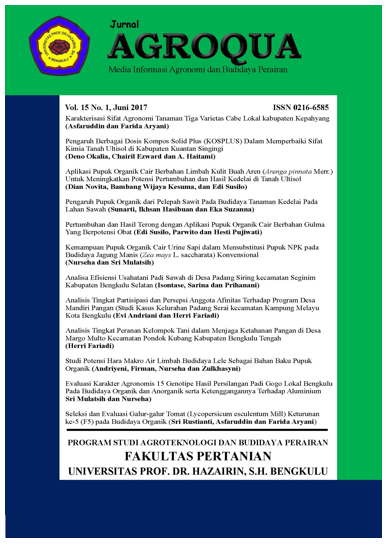PERANAN PUPUK ORGANIK AMPAS TEBU DALAM MENINGKATKAN HASIL TANAMAN OKRA
DOI:
https://doi.org/10.32663/ja.v18i2.1491Keywords:
acid soil, okra, organic fertilizer, sugarcane baggaseAbstract
Okra is one of many vegetables that could be cultivated in tropical climate countries. This crop also has healthy and pharmacy benefits. However, not many farmers grow okra in Indonesia yet. According to some literatures, okra is sensitive to low pH soil. This problem might be solved by applying organic fertilizer, in this case we tried to use organic fertilizer made from sugarcane baggase which available abundantly in Bengkulu. This research aimed to evaluate the effect of sugarcane baggase organic fertilizer on the growth and yield of okra. This study had been done in January-March 2019 in Bengkulu Province. The treatments were three dosages of sugarcane baggase: 10, 15, and 20 t/ha, and 200 kg of NPK (chemical fertilizer) was used as control. All data were analyzed with Anova and LSD 5%. Some important findings in this research as follow. Firstly, organic fertilizer made from sugarcane baggase had sufficient N, P, and K nutrient contents as required by national standard 2019. Secondly, the organic fertilizer had positive effect on decreasing soil acidity. Thirdly, the organic fertilizer showed similar effect as chemical fertilizer had in terms of plant height and number of pod. However, the chemical fertilizer confirmed significant effect than organic fertilizer on behalf of number of leaves, total weight of pods per plant, and productivity of okra (t/ha). The highest productivity of okra by applying the highest dosage of sugarcane baggase organic fertilizer was 6.01 t/ha, meanwhile it was 8.01 t/ha by applying chemical fertilizer.
References
Downloads
Published
Issue
Section
License
Authors who publish with this journal agree to the following terms:
- Authors grant the journal right of first publication with the work simultaneously licensed under a Creative Commons Attribution 4.0 Internasional (CC BY 4.0) Licence that allows others to use and share the work with an acknowledgment of the work's authorship and initial publication in this journal.
- The author(s) still hold the copyright of his/her/their work and retain publishing rights without restrictions such as (but not limited to) patent right, lecture, book and reproduce the article for own purposes.
















